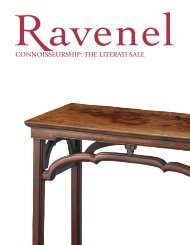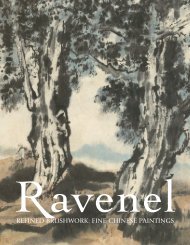亞洲現代與當代藝術 Modern and Contemporary Asian Art
羅芙奧2018春季拍賣會 亞洲現代與當代藝術 Ravenel Spring Auction 2018 Modern and Contemporary Asian Art
羅芙奧2018春季拍賣會 亞洲現代與當代藝術 Ravenel Spring Auction 2018 Modern and Contemporary Asian Art
You also want an ePaper? Increase the reach of your titles
YUMPU automatically turns print PDFs into web optimized ePapers that Google loves.
30Kaikai Kiki Gallery<br />
Yoshitomo NaraDrawings: 1988-2018 Last 30 Years, Kaikai Kiki Gallery, Tokyo<br />
Yoshimoto Nara is an internationally renowned artist from Japan, whose work is often presented in a cartoon style, with bright-eyed children<br />
being the recurring motif. Nara often publicly expresses that he acquires inspiration from art books for children <strong>and</strong> the old records his<br />
listened to during his adolescence. He once commented that he painted with what he actually felt, <strong>and</strong> all the reason <strong>and</strong> meanings ensued<br />
afterwards.<br />
Although his works often find a base in “otaku” aesthetics, the simple lines <strong>and</strong> flat composition often cause his work to be classified as<br />
“Superflat.” However, the artist has strongly rejected the definition as a careless appraisal of his art style. In terms of form <strong>and</strong> expression,<br />
Nara’s techniques do indeed seem similar to the Superflat artists, but unlike in their works, the subjects of Nara’s works never revolve around<br />
criticizing the superficiality of current Japanese society, its traditions, art, or culture. Instead he focuses on painting what is important to him,<br />
<strong>and</strong> pursuing a naked yet true self. Another element that has influenced Nara’s work is Ukiyo-e, an art form from 17th-century Japan which<br />
depicts the daily lives, scenery, <strong>and</strong> theater of the time. The works of artists such as: Kitagawa Utamaro, Katsushika Hokusai, <strong>and</strong> Utagawa<br />
Hiroshige often appear in Nara’s paintings.<br />
These real-life feelings of loneliness <strong>and</strong> detachment that his works display also reflect the indifferent present in Japan’s cities <strong>and</strong> the “otaku”<br />
way of life. He depicts these lonely figures as reflection to his inner soliloquy, which just so happen to echo the dilemma of that generation<br />
<strong>and</strong> the confusion of their souls. Like many self-portraits, Nara’s creations betray an uncompromising spirit <strong>and</strong> a strong defiance of the<br />
outside world. They are pictures of those who have been lost <strong>and</strong> lonely. While the artist contends with the world by pursuing his true inner<br />
self through art, he also communicates with the world, exhibiting the energy of his existence through art, <strong>and</strong> soothing the wounds of the<br />
lonely. Or perhaps it is a misunderst<strong>and</strong>ing of the outside world, constantly caring about where the eyes of society are actually pointed.<br />
Through an art practice that involves simple, amusing paintings, Nara has found a way to depict the dilemma <strong>and</strong> embarrassment of<br />
generations of people, speaking to that experience with a relaxed posture: "Well, beyond emptiness, it's a free life!"







